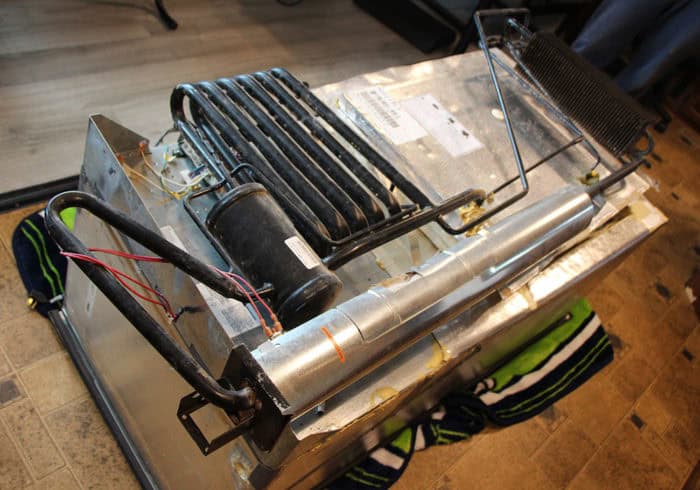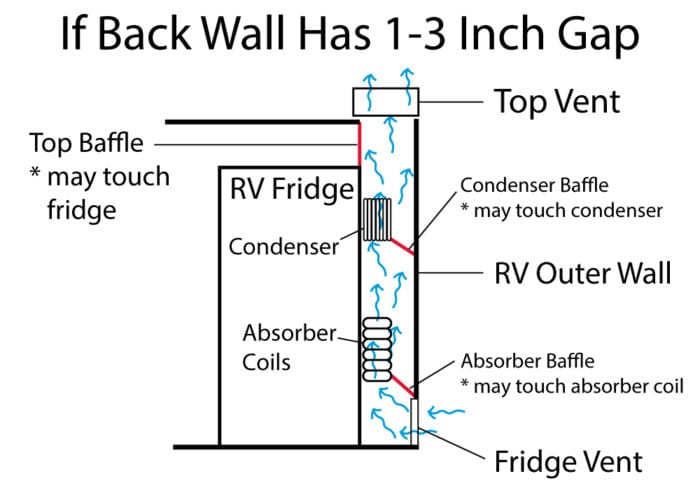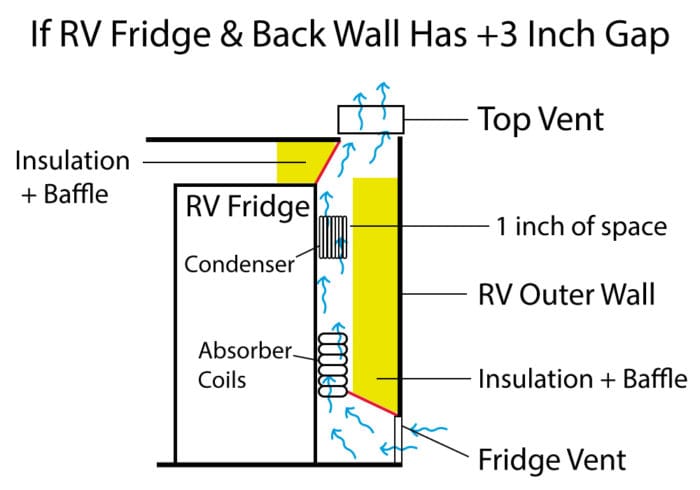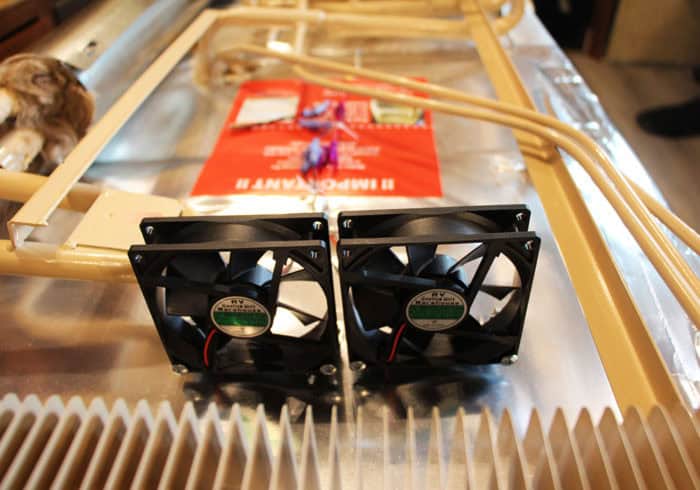How Does An RV Refrigerator Work?
RV refrigerators are amazing. They can run on both electricity and propane and they take up very little space in an RV.
Unlike traditional refrigerators an RV fridge doesn’t use a compressor to cool, that would require too much power.
Related Product: Use a portable 12 Volt Refrigerator/Freezer (click to view on Amazon) to add extra fride/freezer space in your RV or as an emergency backup.
Instead, they use a method called absorption.
Absorption fridges are perfect for RVers since they can be run with either gas or an electric heating element. They also require no moving parts (except for the liquid inside).
Basically, there is a system of pipes behind your RV fridge, these pipes are usually filled with ammonia and water but in some special cases, they can also be filled with helium.

The heat source boils the ammonia and water solution causing the ammonia to evaporate and flow into a condenser that is also filled with hydrogen gas.
The process releases extra heat out of the system (out of the top of the fridge). What’s left is a cooling solution that mixes with the warm air inside of the RV fridge to cool it down.
For an RV fridge to work properly via absorption a few important factors are required.
You need a strong heat source, it could be gas or electricity, and you also need good airflow through the fins and coils in the back to help get rid of the excess heat the ammonia is putting off.
Getting proper airflow through the heating/cooling element of your RV fridge is one of the most important ways to keep an RV fridge cooling properly, especially in hot outside temperatures.
If you are having trouble with the heat source part, especially when running the RV fridge on gas, check out this post here for a simple fix you can try to get things running right again.
Even if your problem was originally the heat source it’s still a good idea to correct the airflow issues in the back to make your fridge more efficient. It will also help keep the heat from getting inside your RV as well.
How Proper Spacing & Insulation Helps An RV Fridge Cool Better
The manufacturers of RV fridges have guidelines for the maximum spacing that should be between the sides and the back of the units.
Unfortunately, not all RV manufacturers follow these guidelines. A lot of times an RV fridge is simply placed in the space made for it and no extra work is done to properly insulate the sides and the back wall.
The reason you want good insulation and to follow the spacing guidelines is to stop extra heat from entering the living space of your RV and to help create a draft through the absorber tubes and condenser of the RV fridge to get rid of the heat being put out.
See Also: What Does Oil In An RV Propane Regulator Mean? + How To Fix
If there’s too much space between the back of the RV fridge and the back wall of the RV the air won’t flow through the condenser. This causes the heat to be trapped and your RV fridge won’t cool as well as it’s supposed to.
If the cabinet above the fridge has no insulation between the back of it and the refrigerator space the hot air will transfer into your RV instead of through the top air vent.
Improper insulation will also let in cold air during cold weather camping and hot air during summer camping.
How Much Space Should Be Between The Back RV Wall And RV Fridge?
According to RV fridge manuals like this one by Thetford (click to view), there is only supposed to be a small amount of space between the back wall and the RV fridge cooling unit, most manufacturers recommend less than 1 inch.
There’s also supposed to be very little space between the sides of the fridge and the cabinets. In fact, they recommend installing baffles in the back to seal off the sides completely.
If you open the bottom outside vent to your RV fridge and look up to the roof you will most likely see a large gap between the heating unit and the back wall.
See Also: 50 Must-Have RV Kitchen Accessories For Full Time RV Living
Gaps larger than 1 inch mean that the air that’s supposed to be flowing from the bottom to the top of the fridge is most likely following the gap instead of flowing through the coils and condenser fins.
This is why your RV fridge is having a hard time getting rid of excess heat and cooling properly, especially in hot temperatures.
Adding baffles and insulation to the back wall will correct the airflow problem and help the RV fridge condenser fins get rid of unwanted heat so it can cool the air inside of the fridge better.
If you insulate the back wall it will also help regulate the temperature inside the RV because it won’t allow hot or cold air from outside into the RV as easily.
RV Fridge Baffles & Insulation
When we pulled out the fridge in our travel trailer to add fans and replace the heating element there was zero insulation along the sides and no insulation or baffles added to the back wall to help create proper airflow.
Even though we were adding fans we were going to do a little bit more work to get our RV fridge running right.
What Are RV Fridge Baffles?
Baffles in the RV fridge world are basically pieces of sheet metal used to block gaps you don’t want air going through.
Insulation could also be considered a kind of baffle since it also stops air from flowing in a certain area.
In the graphic below you can see that baffles are added to close the gap between the RV fridge parts and the wall of the RV.
The baffles redirect the air towards the absorber coils and the condenser to help cool them off.
If there’s just a small gap between 1-3 inches you can just add some baffles to correct the problem.

If there’s a huge gap between the back wall of your RV and the back of the RV fridge you could combine insulation with sheet metal baffles to direct air through the heating element.

There will also be some gaps on the sides of the fridge. Some RV manufacturers add a little fiberglass insulation to the sides and others don’t.
If there is no insulation on the sides of your RV fridge you should add some.
If the gap is extra large and it looks like some air may be able to get through you may want to consider adding baffles or insulation tape to the back of the RV fridge to stop air from getting out along the sides.
What Kind Of Insulation Should I Use Behind An RV Fridge?
If you want to insulate the wall behind the RV fridge there are a few ways you could do it.
Some people secure fiberglass wall insulation (click to view on Amazon) on the back wall and others use hard foam insulation (click to view on Amazon) with a heat resistant barrier (click to view on Amazon) on it.
Deciding on what kind of insulation to use depends a lot on how big the gap is. You want to leave around 1 inch between the insulation and the RV fridge heating element.
See Also: Best 12 Volt Refrigerator Freezer For Camping & Travel
I think combining sheet metal baffles with insulation is a great way to keep air flowing exactly where you want it and also keep either super hot or cold temperatures from getting inside the RV.
Don’t forget to insulate the cabinet above the RV fridge.
Most manufacturers just put a piece of trim wood in the back of the above fridge cabinet. This isn’t nearly enough insulation to stop all the heat coming off of the condenser from entering your RV.
If you move the back piece of wood in a few inches and add some insulation and a baffle it will not only help the heat escape the RV more easily it will also help insulate your entire RV.
Add Fans To RV Fridge To Increase Airflow & Efficiency
Even with perfectly placed insulation and baffles sometimes RV refrigerators have a hard time staying cool in hot temperatures.
One way to fight that is to add a small remote or thermostat controlled 12V fans (click to view on Amazon) to the back to help increase airflow.
The best spot to place fans is below the RV fridge condenser. If the fans sit between the condenser and absorber coils they can move air from both the coils and the condenser.
You want the fans to be blowing air up when in this position.

We added two fans to the back of our RV fridge. We connected them to the same 12V wire that powers the RV fridge so they are run using the RV batteries.
Since they’re just small fans they don’t use very much electricity and they only kick on when the area behind the RV fridge reaches a certain temperature.
See Also: How We Store & Transfer Extra Water To Our RV When Camping
Since adding the RV fridge fans the fridge has been getting a lot colder and we have been able to turn down the temperature one level, even in the summertime.
We’ve also noticed that the camper fridge has gotten a little more efficient. A few days have been added between propane fill-ups which means a lot when you are full-timing in your RV.
Have any more questions about insulating the area behind an RV fridge or how much space there should be? Leave a comment below.


The ARP Fridge Defend works great to prevent overheating your fluids and killing your frig. Also added a couple fans in each exterior vent. Bottom sucking air in and top blowing out.
Is the insulation standard House “soft wall insulation?” I am concerned with Fire?
Is there much danger of fire from the fridge heat on painted paneling or wood trim?
I’m trying to build the cabinet around the fridge I put in my Horse Trailer.
Thanks for this article and any clarification for my questions.
Hi Rick,
If you use fiberglass insulation that’s fire retardant, or use a heat shield, you shouldn’t have to worry about fires. Also, make sure there’s still a decent gab between the coils and insulation. You don’t want the insulation to be touching the coils.
Most RVs have the fridge built into the cabinets. There’s sometimes even a storage area on top of the fridge. I don’t think you should have any issues there so long as the back of the fridge is properly vented with a lower and upper vent for heat to escape.
What can we do if the back vent is directly in front of the coils? We have a small electric fan pointed onto the coils, but isn’t helping much.
Btw – this is very informative!